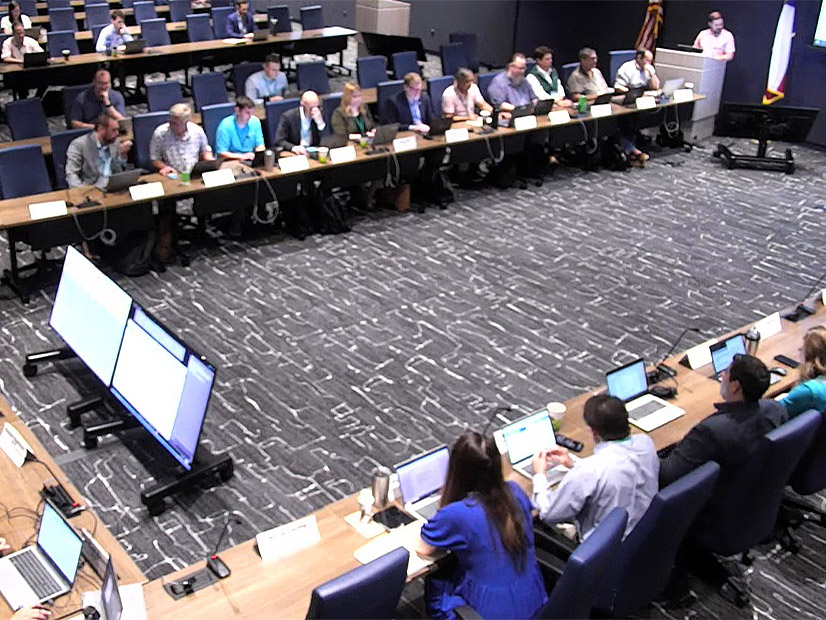ERCOT staff said last week that it faces a tight timeline to add a new ancillary service by Dec. 1, 2024, as required by a recently enacted Texas law.
Texas lawmakers passed a sunset bill (House Bill 1500) that includes a directive to ERCOT to develop an uncertainty product called dispatchable reliability reserve service (DRRS). Based on historical variations in availability for each season, the DRRS’ criteria require participants to be online and dispatchable for less than two hours after being deployed and to run for at least four hours at their high sustained limit.
Kenan Ögelman, ERCOT vice president of commercial operations, told the Technical Advisory Committee on June 27 that staff are still working through its options, but that the date is “very, very limiting in terms of what we can do.”
“The only real chance we have to meet that statutory deadline is to use an existing service, but we are hopeful that maybe stakeholders will have some brilliant idea that we didn’t think of,” Ögelman said.
The DRRS’ objective is to reduce ERCOT’s reliance on reliability unit commitments (RUCs), which have soared under the grid operator’s conservative operations posture during the last two years. The legislation requires that RUCs be reduced by the amount of DRRS that is procured and that the product be provided by offline resources.
Because ERCOT also uses RUCs for local reliability needs, as required by NERC, Ögelman said RUC reductions can only be achieved when they are not needed to cover load and reserve obligations. He also warned that DRRS’ deployment will have implications on prices as its reliance on offline resources means there will be less energy available for dispatch.
“I do think there are going to be things that impact both forward positions and contracts and so forth,” Ögelman said.
Given the time constraints, members discussed repurposing other ancillary services, including its first new product in more than 20 years, ERCOT contingency reserve service (ECRS), as well as non-spin reserve service. ECRS provides the system with additional capacity that can ramp in 10 minutes to respond to short-term net load ramps, and non-spin offers capacity that can be available in 30 minutes to cover forecast errors or to replace deployed reserves. (See “New Ancillary Service Deployed,” ERCOT Board of Directors Briefs: June 19-20, 2023.)
Carrie Bivens, who leads ERCOT’s Independent Market Monitor, said she was “disheartened” by the discussion of procuring more ECRS and called for a holistic review of ancillary services.
“I like the idea of repurposing non-spin … so adding more is going to have unintended consequences,” she said. “A big portion of the non-spin that gets procured is for six-hour load-forecast uncertainty, and I don’t know why you need a 10-minute online product to handle that. I think we have too many megawatts behind the house right now.”
Staff plan to schedule workshops in July to solicit broader stakeholder input and continue to evaluate the pros and cons of other alternatives. Discussions with the Public Utility Commission and stakeholders will continue into August, when staff will also begin to develop the protocols. Ögelman said he hopes to bring a recommendation to the Board of Directors in October and secure the PUC’s approval in November, giving staff a year to translate the protocols into requirements, develop the software and deploy the product.
“None of this is set in stone,” Ögelman said.
Eric Goff, who represents residential consumers, said the uncertainty over the ancillary services market makes it difficult for retailers to determine their charges to consumers.
“The sooner we can resolve this, the better,” he said. “The uncertainty could cause problems. This also ties into the importance of the ancillary services methodology.”
Real-time Co-optimization Is Back
ERCOT’s Matt Mereness told the committee that staff will “blow the dust off everything” in resuming work this week on the real-time co-optimization (RTC) project.
The market mechanism would expand ERCOT’s real-time market by clearing energy and ancillary services every five minutes, as most other grid operators already do. However, it has been on hold since the February 2021 winter storm. ERCOT leadership has said RTC’s reliability benefits in addressing future operational challenges make the tool a strategic priority.
“The key delivery areas that we have is heads down on [writing] the business requirements [and] getting the band back together,” Mereness said. “We’re off and running with this program.”
Staff and market participants drafted and received approval for eight nodal protocol revision requests (NPRRs) related to RTC before the project was halted. However, a battery task force was unable to complete its work on state-of-charge modeling when dispatching batteries. With batteries expected to be capable of providing 14 GW of energy by 2025 and RTC touching almost every major system, Mereness said, staff and stakeholders will also have to address battery functionality as part of the project’s effort.
An updated ERCOT impact analysis has reduced the project’s costs down to about $50 million to deploy in 2026, thanks to some hardware savings and “right-sizing” some of staff’s efforts.
The RTC’s development will begin in April 2024, Mereness said, with the primary risk being maintaining staff availability without interruption during the 3.5-year effort.
“We know this is a squeeze play,” he said. “RTC doesn’t come in and take over everything; it has to fit in with everything else. But the executive team said, ‘Let’s do this and keep the foot on the pedal where we can to keep this thing moving forward.’”
7 Revision Requests Pass
TAC unanimously approved a combination ballot that included two NPRRs, two revisions to the nodal operating guide (NOGRRs), an other binding document request (OBDRR), and single changes to the load-profiling (LPGRR) and planning guides (PGRR). If approved by the board, these changes would:
-
- NPRR1150: require qualified scheduling entities (QSEs) that represent resource entities, emergency response service resources or other QSEs, and that receive or transmit wide area network (WAN) data to maintain connections to the ERCOT WAN and a secure private network.
- NPRR1163 and LPGRR070: discontinue the process of evaluating interval data recorder meters to determine whether any are weather-sensitive.
- NOGRR230: ensure the WAN data transmission’s integrity by requiring data be shared in a manner that prevents denial of service and distributed denial-of-service attacks.
- NOGRR251: add cold weather conditions to the template used for developing emergency operations plans to align with NERC Reliability Standard EOP-011-2 (Emergency Preparedness and Operations).
- OBDRR045: edit the demand response data definitions and technical specifications, including modifications to the electric service identifiers list provided to retail electric providers.
- PGRR103: require interconnecting entities to complete all conditions for commercial operation of a generation resource or energy storage resource within 180 days of receiving ERCOT’s approval for initial synchronization.





